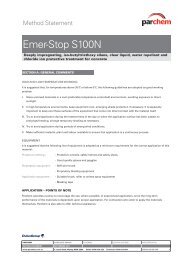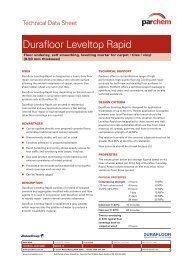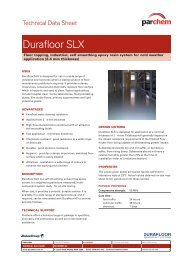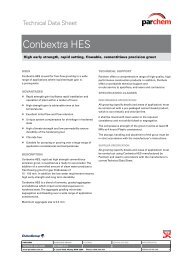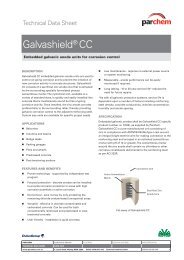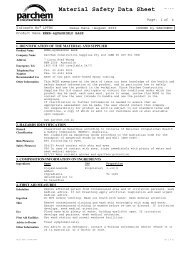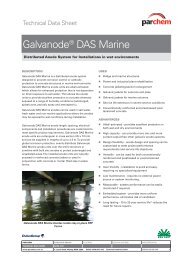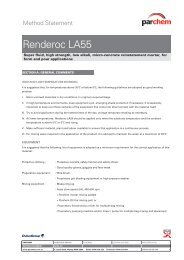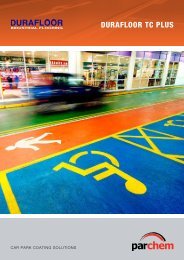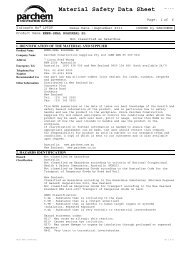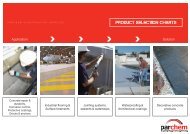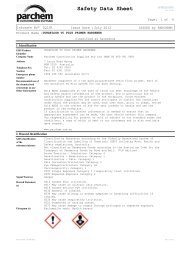Conlift Edgelift Design Manual - Parchem
Conlift Edgelift Design Manual - Parchem
Conlift Edgelift Design Manual - Parchem
You also want an ePaper? Increase the reach of your titles
YUMPU automatically turns print PDFs into web optimized ePapers that Google loves.
DESIGN CONSIDERATIONS FOR CONCRETE LIFTING SYSTEMS<br />
The design engineer must take into account all limit states and failure mechanisms.<br />
The following limit states are to be considered during the design process.<br />
Guidance and recommendatiions can be found in AS3600 (Concrete structures) and<br />
AS1170 (Structural <strong>Design</strong> Actions)<br />
• Anchor strength<br />
• Concrete strength<br />
• Combined anchor strength<br />
If a tension bar is to be installed with the anchor, their joint capacity must be considered.<br />
• <strong>Design</strong> for concrete strength<br />
• Serviceability<br />
• Anchor robustness and flexibility<br />
• Fatigue due to multiple lifting and corrosion<br />
Provided the <strong>Conlift</strong> anchor is showing no signs of corrosion or damage the are safe for multiple lifts.<br />
• Atmospheric Corrosion<br />
All <strong>Conlift</strong> <strong>Edgelift</strong> Amchors are galvanised (hot dipped) to ensure the are resistant to<br />
atmosphericcorrosion. Stainless steel anchors are available for more aggressive environments.<br />
The lifetime of <strong>Conlift</strong> galvanised anchor coatings depends upon the category as shown below.<br />
Atmospheric Corrosivity<br />
Zones<br />
ISO 9223:2012<br />
and<br />
ISO 14713-1:2009<br />
Description<br />
Typical<br />
Environment<br />
Corrosion rate for the first<br />
year of exposure (µm/y)<br />
Mild Steel Zinc 14 µm<br />
100 g/m²<br />
Typical service life (years)<br />
Galvanizing thickness (µm) and coating mass (g/m²)<br />
20 µm<br />
140 g/m²<br />
42 µm<br />
300 g/m²<br />
85 µm<br />
600 g/m²<br />
125 µm<br />
900 g/m²<br />
C1 Very low Dry indoors<br />
≤1.3<br />
≤0.1 100+ 100+ 100+ 100+ 100+<br />
C2 Low Arid/Urban<br />
inland<br />
>1.3 to ≤25 >0.1 to ≤0.7 21-<br />
100+<br />
36-<br />
100+<br />
50-<br />
100+<br />
100+ 100+<br />
C3 Medium Coastal or<br />
industrial<br />
>25 to ≤50 >0.7 to ≤2.1 7-21 12-36 17-50 40-<br />
100+<br />
60-<br />
100+<br />
C4 High Calm seashore<br />
>50 to ≤80 >2.1 to ≤4.2 4-7 6-12 8-17 20-40 30-60<br />
C5 Very High Surf sea-shore >80 to ≤200 >4.2 to ≤8.4 2-4 3-6 4-8 10-20 15-30<br />
CX Extreme Off-shore >200 to<br />
≤700<br />
>8.4 to ≤25 1-2 1-3 1-4 3-10 5-15<br />
Reproduced with permission of the Galvanisers Association of Australia : www.GAA.com.au<br />
Note 1 This table is an extrapolation of well-established corrosion rates and is supported by case history evidence in Australia, where<br />
service life records of 50 years are common and up to 110 years are recorded. The corrosion rates are consistent with ISO<br />
9223:2012 and ISO 14713-1:2009.<br />
Note 2 Because the actual galvanizing thickness applied is usually well above the specification minimum, the service<br />
lives quoted in rain exposed locations are likely to be conservative. In addition, ISO 9224:2012 applies lower<br />
corrosion rates for both steel and zinc where the object is exposed to long term steady state environmental conditions.<br />
Note 3 Sheltered and not rain-washed surfaces, in a marine atmospheric environment where chlorides are deposited, can experience a<br />
higher corrosivity category due to the presence of hygroscopic salts.<br />
Note 4 The coastal zone is defined as between 100 metres to 1 km inland from sheltered seas and between 1 km and<br />
10 – 50 km from surf beaches depending upon prevailing winds and topography.<br />
Note 5 Measured corrosion rates for steel in selected locations in Australia are shown in AS 4312:2006.<br />
Note 6 Galvanizing thicknesses of 14 µm (100 g/m²) and 20 µm (140 g/m²) are typically applied by an in-line process.<br />
Note 7 A more complete description of each of the typical environments is available in ISO 9223:2012, ISO 14713-<br />
1:2009, AS 4312:2006, and from the GAA.<br />
15



